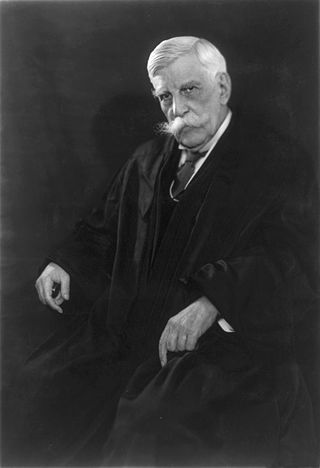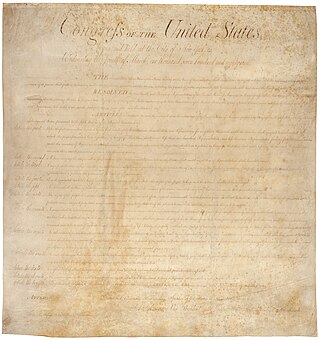
Clear and present danger was a doctrine adopted by the Supreme Court of the United States to determine under what circumstances limits can be placed on First Amendment freedoms of speech, press, or assembly. The test was replaced in 1969 with Brandenburg v. Ohio's "imminent lawless action" test.
Fighting words are written or spoken words intended to incite hatred or violence from their target. Specific definitions, freedoms, and limitations of fighting words vary by jurisdiction. The term fighting words is also used in a general sense of words that when uttered tend to create a verbal or physical confrontation by their mere usage.
Schenck v. United States, 249 U.S. 47 (1919), was a landmark decision of the U.S. Supreme Court concerning enforcement of the Espionage Act of 1917 during World War I. A unanimous Supreme Court, in an opinion by Justice Oliver Wendell Holmes Jr., concluded that defendants who distributed flyers to draft-age men urging resistance to induction could be convicted of an attempt to obstruct the draft, a criminal offense. The First Amendment did not protect the defendants from prosecution, even though, "in many places and in ordinary times, the defendants, in saying all that was said in the circular, would have been within their constitutional rights. But the character of every act depends upon the circumstances in which it is done." In this case, Holmes said, "the words used are used in such circumstances and are of such a nature as to create a clear and present danger that they will bring about the substantive evils that Congress has a right to prevent." Therefore, the defendants could be punished.
Dennis v. United States, 341 U.S. 494 (1951), was a United States Supreme Court case relating to Eugene Dennis, General Secretary of the Communist Party USA. The Court ruled that Dennis did not have the right under the First Amendment to the United States Constitution to exercise free speech, publication and assembly, if the exercise involved the creation of a plot to overthrow the government. In 1969, Dennis was de facto overruled by Brandenburg v. Ohio.
Brandenburg v. Ohio, 395 U.S. 444 (1969), was a landmark decision of the United States Supreme Court interpreting the First Amendment to the U.S. Constitution. The Court held that the government cannot punish inflammatory speech unless that speech is "directed to inciting or producing imminent lawless action and is likely to incite or produce such action". Specifically, the Court struck down Ohio's criminal syndicalism statute, because that statute broadly prohibited the mere advocacy of violence. In the process, Whitney v. California (1927) was explicitly overruled, and Schenck v. United States (1919), Abrams v. United States (1919), Gitlow v. New York (1925), and Dennis v. United States (1951). were effectively overturned.
Whitney v. California, 274 U.S. 357 (1927), was a United States Supreme Court decision upholding the conviction of an individual who had engaged in speech that raised a threat to society. Whitney was explicitly overruled by Brandenburg v. Ohio in 1969.
Abrams v. United States, 250 U.S. 616 (1919), was a decision by the Supreme Court of the United States upholding the 1918 Amendment to the Espionage Act of 1917 which made it a criminal offense to urge the curtailment of production of the materials necessary to wage the war against Germany with intent to hinder the progress of the war. The 1918 Amendment is commonly referred to as if it were a separate Act, the Sedition Act of 1918.
Chaplinsky v. New Hampshire, 315 U.S. 568 (1942), was a landmark decision of the US Supreme Court in which the Court articulated the fighting words doctrine, a limitation of the First Amendment's guarantee of freedom of speech.
"Imminent lawless action" is one of several legal standards American courts use to determine whether certain speech is protected under the First Amendment of the United States Constitution. The standard was first established in 1969 in the United States Supreme Court case Brandenburg v. Ohio.
"Shouting fire in a crowded theater" is a popular analogy for speech or actions whose principal purpose is to create panic, and in particular for speech or actions which may for that reason be thought to be outside the scope of free speech protections. The phrase is a paraphrasing of a dictum, or non-binding statement, from Justice Oliver Wendell Holmes, Jr.'s opinion in the United States Supreme Court case Schenck v. United States in 1919, which held that the defendant's speech in opposition to the draft during World War I was not protected free speech under the First Amendment of the United States Constitution. The case was later partially overturned by Brandenburg v. Ohio in 1969, which limited the scope of banned speech to that which would be directed to and likely to incite imminent lawless action.

Masses Publishing Co. v. Patten, 244 F. 535, was a decision by the United States District Court for the Southern District of New York, that addressed advocacy of illegal activity under the First Amendment.
Feiner v. New York, 340 U.S. 315 (1951), was a United States Supreme Court case involving Irving Feiner's arrest for a violation of section 722 of the New York Penal Code, "inciting a breach of the peace," as he addressed a crowd on a street.
Terminiello v. City of Chicago, 337 U.S. 1 (1949), was a case in which the Supreme Court of the United States held that a "breach of peace" ordinance of the City of Chicago that banned speech that "stirs the public to anger, invites dispute, brings about a condition of unrest, or creates a disturbance" was unconstitutional under the First and Fourteenth Amendments to the United States Constitution.
Kunz v. New York, 340 U.S. 290 (1951), was a United States Supreme Court case finding a requirement mandating a permit to speak on religious issues in public was unconstitutional. It was argued October 17, 1950, and decided January 15, 1951, 8–1. Chief Justice Vinson delivered the opinion for the Court. Justice Black and Justice Frankfurter concurred in the result only. Justice Jackson dissented.

In the United States, some categories of speech are not protected by the First Amendment. According to the Supreme Court of the United States, the U.S. Constitution protects free speech while allowing limitations on certain categories of speech.
Communist Party of Indiana v. Whitcomb, 414 U.S. 441 (1974), was a United States Supreme Court case based on the First Amendment to the U.S. Constitution that invalidated Indiana's loyalty oath requirement.

The Smith Act trials of Communist Party leaders in New York City from 1949 to 1958 were the result of US federal government prosecutions in the postwar period and during the Cold War between the Soviet Union and the United States. Leaders of the Communist Party of the United States (CPUSA) were accused of violating the Smith Act, a statute that prohibited advocating violent overthrow of the government. The defendants argued that they advocated a peaceful transition to socialism, and that the First Amendment's guarantee of freedom of speech and of association protected their membership in a political party. Appeals from these trials reached the US Supreme Court, which ruled on issues in Dennis v. United States (1951) and Yates v. United States (1957).
Sacher v. United States, 343 U.S. 1 (1952), was a United States Supreme Court case in which the Court upheld the convictions of five attorneys for contempt of court.

National Gay Task Force v. Board of Education of the City of Oklahoma City, Oklahoma, 729 F.2d 1270, is a decision by the Court of Appeals for the Tenth Circuit that upheld in part, and struck down in part, a law allowing schools to fire teachers for public homosexual conduct. It was the first federal appellate court decision to deny that sexual orientation is a suspect classification. It was affirmed by an equally divided vote in the United States Supreme Court.
Hate speech in the United States cannot be directly regulated by the government due to the fundamental right to freedom of speech protected by the Constitution. While "hate speech" is not a legal term in the United States, the U.S. Supreme Court has repeatedly ruled that most of what would qualify as hate speech in other western countries is legally protected free speech under the First Amendment. In a Supreme Court case on the issue, Matal v. Tam (2017), the justices unanimously reaffirmed that there is effectively no "hate speech" exception to the free speech rights protected by the First Amendment and that the U.S. government may not discriminate against speech on the basis of the speaker's viewpoint.





